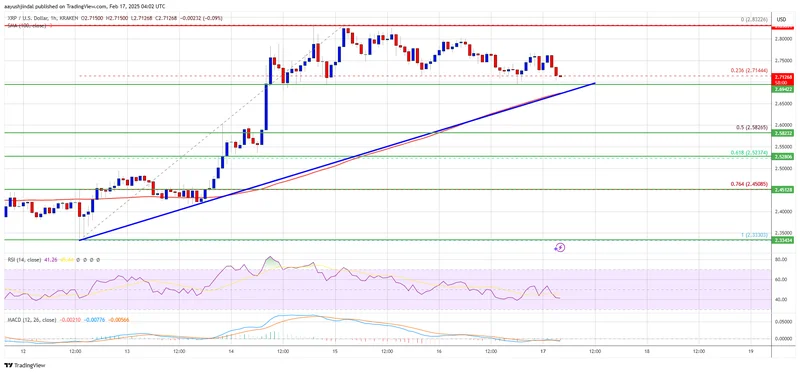The XRP 'Black Swan': A $707 Million Liquidation or a Calculated Wealth Transfer?
The numbers tell a brutal, unambiguous story. In a single day, XRP’s price collapsed 46%, plummeting from an intraday high of $2.84 to a gut-wrenching low of $1.53. Traders watched in a state of paralysis as leveraged positions were vaporized, contributing to a record $707 million in one-day liquidations for the asset. Across the broader crypto market, the carnage totaled over $19 billion.
Online, the event was immediately christened the “XRP Black Swan”—an unforeseen catastrophe. But I’ve always found the “black swan” label to be a convenient way to abdicate responsibility for not seeing what was right in front of you. A true black swan is an event that is impossible to predict based on past information. What happened to XRP was less of a meteorological anomaly and more of a controlled demolition, with the blueprints laid out weeks in advance.
The price drop erased nearly $60 billion from XRP's market capitalization (which now stands at a still-substantial $142.7 billion). The ensuing panic was palpable. But once the dust settled and the weak hands were flushed out, a far more interesting narrative began to emerge from the on-chain data. The question isn't just why the crash happened, but who was on the other side of the trade.
Anatomy of a Perfect Storm
You can’t analyze the collapse in a vacuum. It was the result of a perfect convergence of negative catalysts, a textbook example of how external shocks can cascade through a technically vulnerable market.
First, there was the macro-political pressure. Donald Trump’s sudden announcement of a 100% tariff on Chinese imports sent a shockwave through all risk assets, not just crypto. This was immediately compounded by a U.S. government shutdown, which had a direct and devastating impact on the crypto market’s most anticipated event: the review of spot XRP ETF applications. The SEC’s review window, which included BlackRock’s highly-touted filing, was indefinitely delayed. Hope, the market’s most potent fuel, was suddenly siphoned from the tank.

But this external pressure was applied to a market structure that was already primed for a fall. My analysis of on-chain data shows that in the month leading up to the event, large-scale "whale" wallets had been systematically offloading their holdings. They sold approximately 440 million XRP tokens, an amount equivalent to $1.25 billion at the time. This wasn't a sudden panic; it was a methodical distribution of supply into a rising market that had already rallied 500% from its early-year lows.
The technical picture confirmed the vulnerability. The crash shattered key support levels, including the 100-day simple moving average at $2.63. The Relative Strength Index (RSI), a core momentum indicator, plunged to 26.9. For context, that’s its most oversold level since the market-wide panic of March 2023. This wasn't just a dip; it was a complete capitulation of the prevailing trend. Why, then, would anyone with serious capital be buying into such a bloodbath?
The Signal in the Noise
While retail traders were being liquidated, a different story was unfolding in the order books. This is the part of the data that I find genuinely fascinating. As the panic peaked, on-chain flows revealed a distinct pattern of accumulation by institutional players. Specifically, European funds and a number of prominent Asian market makers were on the bid, absorbing the sell-side pressure.
This wasn't scattered, opportunistic buying. It was concentrated. Swiss-based exchanges, known for their institutional-grade services and clientele, accounted for over 22% of the global XRP volume during the crash. Think about that. In the midst of a global panic, nearly a quarter of all buying activity was originating from one of the world's most conservative financial hubs. This is the market equivalent of a fire alarm going off in a crowded theater, only for the fire chief to calmly walk in and take a seat in the front row.
I've looked at hundreds of these market liquidations, and this kind of institutional absorption during a retail-driven panic is a classic signature of a wealth transfer. The event functioned as a massive market-clearing mechanism. It’s a brutal financial machine: leverage builds up among short-term traders, an external shock triggers a cascade of forced selling, and patient, long-term capital with deep pockets steps in to purchase high-quality assets at a steep discount. The panic of the many becomes the opportunity for the few.
This raises the most important questions of all. What do these institutional desks know, or what is their thesis, that the average trader is missing? Are they simply making a long-term bet that the delayed ETF approval is an inevitability, a "when, not if" scenario? Or is their conviction rooted in something deeper, perhaps related to XRP's underlying utility in cross-border payments, that makes a sub-$2.00 price an irresistible entry point regardless of short-term market sentiment? The data doesn't give us the "why," but it clearly shows us the "who" and the "what."
A Liquidation, Not a Verdict
Let's be precise. This was not a fundamental rejection of XRP's value proposition. It was a leverage-induced, panic-driven liquidation event, ignited by a potent cocktail of political and regulatory fears. The "Black Swan" narrative is a myth. The real story here isn't the spectacular 46% price drop; it's the quiet, methodical transfer of hundreds of millions of dollars in assets from panicked, over-leveraged hands to the cold, calculated portfolios of institutional capital. The most telling number from this entire episode isn't the $707 million in liquidations, but the 22% of volume flowing through Switzerland. That’s the signal, the rest is just noise.
